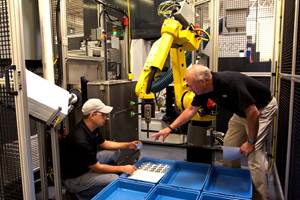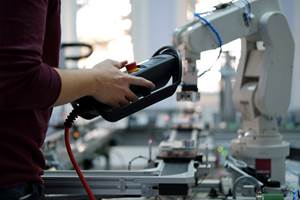Building a Functional Team
Think of advanced manufacturing as a kind of team sport. Stack your team with the best players. Here are six steps.
Today’s most advanced manufacturers use extremely complicated CNC equipment. Newer five-axis equipment is programmed more like a video game than a machine tool. And with the enhanced precision, speed and capability offered by these machines comes the need for machinists, programmers and operators with higher skills. The cost to attract, develop and retain such a workforce can be crushing. The challenge is to build a talented, cohesive team in both the shop and the front office that is sustainable and cost-effective.
After all, advanced manufacturing is a team sport. Our shop has discovered that the best players share three characteristics: They are humble about their capabilities, they are passionate in their beliefs (both professionally and personally), and they communicate well. These characteristics, combined with measurable expertise, yield a strong team member.
We have found the following six steps crucial for building a strong team:
1. Test everyone. Determine the real, measurable skill level of every technical employee. Conduct technical tests that will reveal both strengths and weaknesses. The results might be an eye-opener for some technicians who have risen in rank through attrition or job-hopping. However, don’t be concerned with fitting people into job requirements; instead, consider modifying job requirements around team members to leverage their strengths. Machinists in advanced manufacturing environments are professional problem-solvers.
2. “De-conflict” the team. It is imperative that everyone in the company understand that they are part of a team and that everyone’s role on the team is important. Anyone in the organization who does not embrace the team concept (at all levels) is removing himself from the team. Regular interaction among all different levels of the organization encourages communication, and this communication in all directions is crucial to team success.
3. Lead the team. The first step to building a superior team is to recognize, embrace and demonstrate that every member of the team is critical to it. Team members like to lead because it means they are engaged in solutions to problems and their input matters. Getting the right members on the team and enabling them to succeed eliminates the need for middle management. Instead of investing on management levels, invest your time in your team members. Be their leader or coach.
4. Invest in the team. Team members are a manufacturer’s greatest asset, and they are the only asset a shop has that actually can appreciate in value. To realize the real value of teamwork, leadership must “go all in;” forget about clawback. Loyalty is earned through trust built between the team and company leadership. When people leave the company, and eventually a few will, they will compare treatment by every other employer to the way you have treated them. Be the benchmark to which all other employers are compared, and your reputation will attract the most talented people.
5. Retain the team. Think outside the box for ways to attract, develop and retain team members. An annual investment of $5,000-$10,000 per team member, for example, can yield great benefits.
Our company founder, Todd Paul, presents each new shopfloor employee with a complete set of premium tools and high-precision measurement devices, plus a three-tier set of Kennedy machinist toolboxes. This $6,000 investment per person makes a statement about the value we place on our team members and their skills. For the employee’s first five years at the shop, the tools belong to the company; afterward, they become the property of the team member.
Training is the cornerstone for success in any organization. We spend $5,000-$10,000 per team member every year on training and have found that this differentiates us from the competition. Customers, partners and the team members themselves also recognize the value.
6. Pay the team fair market value. As the skill levels of team members improve, so does their fair market value, and they should be paid accordingly. Rather than annual, tenure-based salary increases, recognize achievement of higher skills milestones with compensation that reflects the team member’s new fair market value. Along with boosting morale and promoting teamwork, this approach encourages employees to continuously improve their skills and essentially puts compensation in their own hands.
Advanced manufacturing is a team sport. Any shop can purchase capital equipment, but leveraging that equipment requires a team with the skills and desire to fully embrace advanced manufacturing. Focus on building the best team.
Carl Livesay is the vice president of operations for Land Sea Air Manufacturing, a high-precision, complex-geometry contract manufacturer serving the aerospace, defense and capital equipment industries. More at lsa-mfg.com.
Related Content
Close Collaboration With Customers Brings Job Shop Success
Contract machining operations win when they collaborate closely and openly with customers.
Read MoreOvercoming Barriers to Machine Shop Automation
Industrial automation using robots has improved productivity for operations large and small — so why do some manufacturers shy away from it?
Read MoreMake the Most of Your Interactions With Salespeople
Don’t miss out on products and knowledge that could help your company.
Read MoreSharing the Manufacturing Narrative With Policymakers
Conversations with policymakers represent a chance to communicate our challenges, showcase our passion and impact them with our pride in American manufacturing.
Read MoreRead Next
The Cut Scene: The Finer Details of Large-Format Machining
Small details and features can have an outsized impact on large parts, such as Barbco’s collapsible utility drill head.
Read More3 Mistakes That Cause CNC Programs to Fail
Despite enhancements to manufacturing technology, there are still issues today that can cause programs to fail. These failures can cause lost time, scrapped parts, damaged machines and even injured operators.
Read More










.png;maxWidth=300;quality=90)











